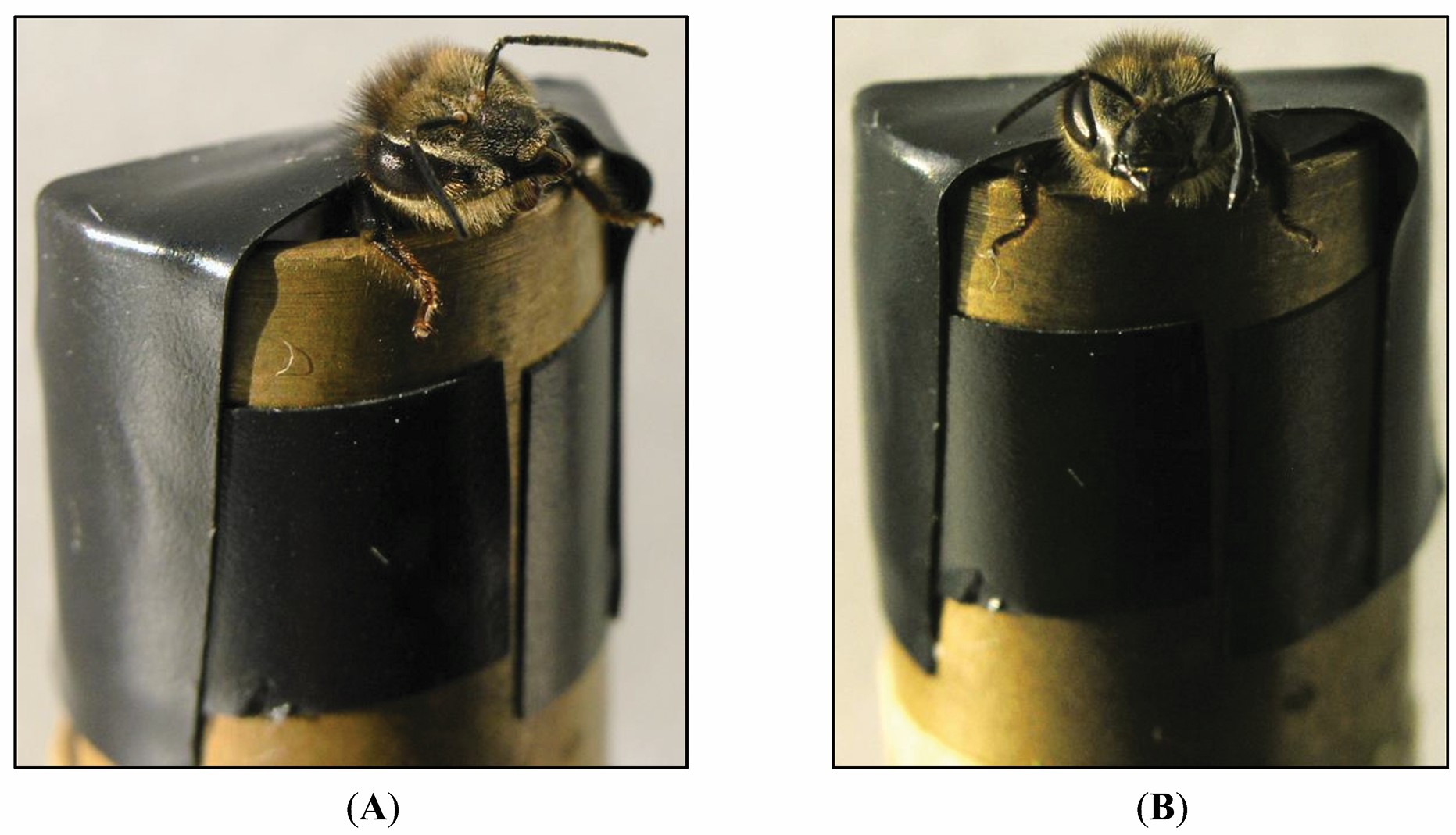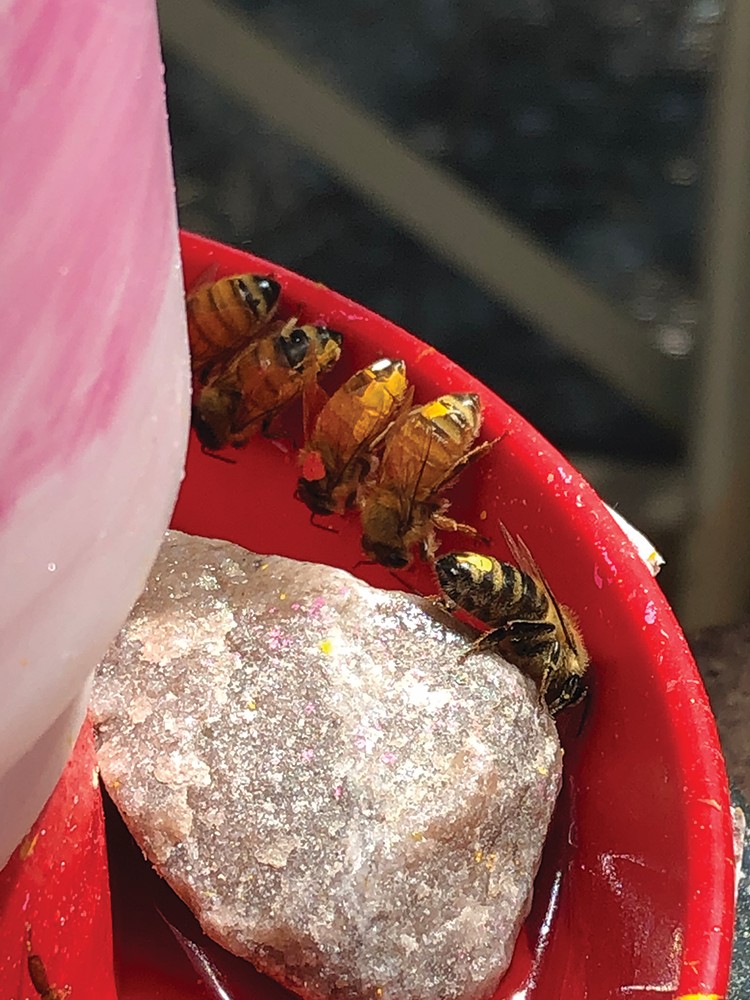Social Thoughts
Jay Evans, USDA Beltsville Bee Lab
Honey bees, like other social insects, think both for themselves and for their colonies. All animals have a degree of awareness of their surroundings and most find a need to communicate within their species. Honey bees carry this to an extreme in that they must be highly communicative in the colony, and highly coordinated with their nestmates. How these social pressures shape the bee brain is a fascinating topic and one that has practical implications for beekeepers. To cut to the chase, honey bees are really VERY smart for an insect. You might predict that an organism with tens of thousands of others backing them up would get a little soft in the head. In fact, by conventional metrics the honey bee brain is remarkable, if a little skewed towards memory and communication.
Chelsea Cook and colleagues at Arizona State University (and now Marquette University for her) conducted a series of experiments to determine some boundaries of bee learning and the genetic variation across bees in their learning styles. In their freely available paper “Individual learning phenotypes drive collective behavior” (Proceedings of the National Academy of Sciences, USA, 2020, vol. 117, pages 17949–17956; https://www.pnas.org/content/117/30/17949), they focused on how bees discriminate between what is important and what can be ignored. In studies of animal behavior, the formal term for this is Latent Inhibition or LI. In practice, it is the ability of an animal to ignore unimportant stimuli, saving energy and brain cells for the things that really matter. Hi-LI individuals, from bees to humans, have an innate sense of what they want and have blinders of sorts for the many other shiny objects they click, crawl, walk, or fly past. They do so at the expense of not benefitting from certain novel experiences.
The group has established that LI is variable across bees, and that the levels of this trait can be increased or decreased by selection. For this paper, they went further and bred bees showing each extreme via artificial insemination with single drones. Fortunately, LI can be measured in queens and drones, as well as in workers. LI was assessed by strapping bees into small seatbelts, offering stimuli and measuring the abilities of bees to favor familiar stimuli via the ‘Proboscis extension response’ (PER). PER is widely used in bee behavioral studies to show how well bees learn and remember cues. It is a simple test that can be used to compare the abilities of bees against each other, other insects, and even mice and teenagers. After testing individual queens and drones using PER, the researchers banked the queens that were outliers showing high or low LI, and also banked the sperm of the males that passed or failed the LI test. With human assistance, Hi-LI sperm met with Hi-LI queens while Low-LI sperm met with Low-LI queens.
Eventually, these scientists established six super colonies that were selected to be faithful to only certain cues in the environment (Hi-LI), six colonies whose progeny were in some ways more open to new adventures (low-LI), six colonies with a mix of both types of workers, and six colonies that were controls not selected in either direction. Control bees were also added to the 18 selected colonies, to give the high and low LI bees some more nestmates.
Happily, bees whose parents had shown Hi-LI and Low-LI traits faithfully represented those traits. This was not surprising after their prior studies but probably a huge relief after all the work to identify, propagate, and measure hundreds of bees. What really sets this paper apart is the ensuing effort to see how bees with these tendencies behave in a real-world setting, and nothing is more real-world for middle-aged worker bees than foraging. Bees from each colony were set up in their own flight tents and were trained to four sweet bait stations. Thanks to a shell game of sorts where baits were added to the bee’s world over several days, one of these stations was ‘familiar’ to bees while the rest were ‘novel’ food sources. As expected, the Hi-LI bees, having found a good thing on day 1, were pretty content recruiting to and feeding from that same feeder even as the other three popped up. Their fidelity led to a ten-fold higher visitation rate to the familiar feeder versus novel ones. In contrast, ‘Low-LI’ bees visited the novel feeders at an equal rate to the original familiar station. What about when Hi-LI and Low-LI bees were mixed together? In these cases, bees still visited the familiar feeders at a higher rate than bees from Low-LI or even control colonies. What drove that? It turns out the Low-LI bees and even control bees in those mixed colonies acquired a preference for familiarity. This insight was gained after painting hundreds of bees of each type distinct colors, so a Hi-LI bee was identifiable, as were Low-LI and control bees. If you have spent so much time identifying traits, consummating bee pairings, and establishing field feeding trials, painting hundreds of bees is a piece of cake and it paid off.
To ice the mechanism for this social shift, and bring even more colony (and possibly beekeeper) relevance to these studies, the researchers also watched individual bees as they danced to recruit others to the food sources. Since distances were short, foragers recruited using the round dance, not the waggle dance, so some information on recruitment preference was lost. However, the bees did show different recruiting skills and energies. Hi-LI bees had significantly more followers for their dances. Not surprisingly, this spurred hi-LI nestmates to forage more often overall and when those nestmates were low-LI to still express a preference for the familiar feeder. Low-LI bees danced often, but to smaller audiences. Future work will have to resolve this relative difference in popularity, but as one hint to the mechanism Hi-LI bees were able to shake out more turns per second than Low-LI bees, and this shaking seems to have swayed their nestmate judges. Overall, these experiments show how a behavioral trait that is fairly abstract (responses to sugar and cues in a lab setting) can be used both to change things at the colony level via breeding and to give insights into how the tendencies of individual bees are converted into colony level behaviors.
This study highlights how the remarkable brain of the honey bee can be shaped by breeding and how that shaping translates into health and behavior at the colony level. If you want to expand your OWN brain with some discussions about how the colony itself can think like a superorganism you will like a long review by Takao Sasaki and Stephen Pratt “The Psychology of Superorganisms: Collective Decision Making by Insect Societies” in the Annual Review of Entomology (2018, vol. 63:259-75, https://doi.org/10.1146/annurev-ento-020117-043249). Here the authors make some pretty bold claims for how colony-level dynamics, reflecting feedback by colony members and stimuli from inside and out, are so predictable that they can be thought of in many ways like individual behaviors. Thinking of the colony as a superorganism is not new, and many will have read efforts on this topic by honey bee scientists such as Thomas Seeley and his students, but actually placing colony behaviors into the more rigorous (hopefully) context of psychology is definitely a page turner. Get out and find some novel feeders.










